Chair Ergonomics: Optimising Comfort and Health at Work
Updated On: October 24, 2025 by Aaron Connolly
Core Principles of Chair Ergonomics
Chair ergonomics is all about designing seats that actually support the way our bodies naturally sit. When a chair fits, it takes the strain off and helps us get through long hours at a desk.
If you get it right, you can avoid musculoskeletal disorders and, honestly, just feel better while working. It’s wild how much difference a good chair makes for comfort and productivity.
What Is Chair Ergonomics?
Chair ergonomics is the science behind making seats that work with our bodies, not against them. Designers look at how our bones and muscles move, then build chairs that help us sit with a healthy posture.
The main aim? Support your spine’s natural S-curve. Your lower back, or lumbar region, takes a lot of weight when you sit, so it needs special attention.
Ergonomic chairs should work for all sorts of body types. There’s no one-size-fits-all.
Some key features you’ll want:
- Adjustable seat height so your feet actually touch the floor
- Lumbar support to keep that lower back curve happy
- Seat depth that leaves a little gap behind your knees—2 to 3 inches is good
- Armrests that let your shoulders relax instead of hunching
A truly ergonomic chair adapts to you, not the other way around. That means less pressure on joints and better blood flow, which, let’s face it, everyone needs.
Why Ergonomics Matters for Workplace Health
Bad chairs? They mess people up. Poor seating causes millions of workers to struggle with back pain, neck issues, and that annoying shoulder tension.
About 54% of office workers say they get back pain because their chairs just don’t cut it. When lumbar support is missing, we all end up slouching and putting extra strain on our spines.
Here’s what can go wrong:
- Chronic lower back pain if lumbar support is missing
- Neck and shoulder aches from craning your head forward
- Tight hip flexors if the seat sits too high
- Legs that tingle or go numb from too much pressure
When you get ergonomic seating right, your spine stays aligned and your weight spreads out evenly. That means no more weird pressure points or nagging aches.
Workplace injuries from bad ergonomics cost the UK around £1.2 billion every year. Investing in the right chair can save a lot of pain—and money—down the road.
Impact of Ergonomics on Productivity
Let’s be honest, nobody works well when they’re uncomfortable. People who sit in ergonomic chairs get more done and stay focused longer.
Studies say productivity can jump by up to 25% with good seating. That’s not nothing.
When a chair makes you fidget, you end up thinking about your back or legs instead of your work. All that discomfort drains your mental energy and makes concentrating tougher.
Here’s what ergonomic seating can do for you:
| Benefit | Impact |
|---|---|
| Reduced fatigue | 15% increase in sustained attention |
| Better posture | 20% improvement in task accuracy |
| Less movement/fidgeting | 30% fewer work interruptions |
| Improved circulation | Sharper thinking and alertness |
People with ergonomic chairs take fewer sick days and usually feel better about their jobs. By the end of the day, they’re less wiped out and can actually finish their tasks.
A good chair means you don’t have to stand up and stretch every five minutes. More time working, less time dealing with aches.
Key Features of an Ergonomic Chair
A solid ergonomic office chair needs to adjust to your body, not the other way around. The best ones pay attention to how different people actually sit and support healthy posture even on those long, endless days.
Identifying Essential Adjustments
Adjustability is everything when it comes to ergonomic chairs. Everyone’s built differently, so your chair should meet you where you are.
Start with seat height. Your hips and knees should be at a 90-100 degree angle, feet flat on the floor. No dangling legs or pressure under your thighs.
Seat depth is next. When you’re sitting all the way back, you want a 2-3 finger gap between your knees and the seat’s edge. Long legs? You’ll need more depth.
The backrest angle should start at 90-100 degrees, but it’s even better if you can tilt it back to 120-130 degrees for a stretch.
Here’s a quick checklist:
- Seat height (matches your leg length)
- Seat depth (fits your thighs)
- Backrest angle (upright and reclined)
- Lumbar support (height and depth)
- Armrest height (if you use them)
The Role of Ergonomic Design
Good ergonomic design is more than just adjustments. The best chairs actually support your spine’s natural curves.
Lumbar support is huge. Your lower back has a natural arch, so the lumbar support should move up and down, and in and out, to fit your shape.
Seat cushioning matters too. If it’s too soft, you end up sinking. Too hard, and you get sore spots. Breathable materials help keep you cool during long hours.
Mobility features—like swivel bases and smooth wheels—let you move without twisting awkwardly. You shouldn’t have to strain just to reach your keyboard.
A flat or slightly forward-tilted seat helps keep your pelvis in the right spot. That way, you avoid extra pressure on your lower back.
Prioritising Individual Fit
No chair fits everyone perfectly. You need to match the chair to your body and how you work.
Torso length affects where you want lumbar support. Tall? You’ll want it higher. Short? Lower is better.
Leg proportions change how you set seat height and depth. Longer thighs? Go for more seat depth. Longer lower legs? Raise the seat.
How you work matters too. If you’re always reaching, armrests might get in the way. If you barely move, you’ll want all the adjustability you can get.
Here’s what to focus on:
- Long legs: Look for a wide seat height range and deep seat
- Short torso: Make sure the lumbar support goes low enough
- Move around a lot: Smooth wheels and swivel bases are key
- Sit for hours: Go for cushioning and a reclining back
Best advice? Try out chairs in person with your own measurements. Don’t just trust the label.
Backrest and Lumbar Support
A decent backrest with good lumbar support keeps your spine in line and helps you avoid back pain when you’re stuck at your desk for hours. The trick is finding the right setup for your shape and size.
The Importance of Backrest Design
The backrest is the backbone (pun intended) of any ergonomic chair. It should follow your spine’s S-curve and give you solid support.
Height matters. Your backrest should reach up to your shoulder blades, giving support to both your lower and upper back.
The angle is just as important. Backrests that tilt between 100-110 degrees take a lot of pressure off your spine—sometimes up to 40% less than sitting bolt upright. That’s a relief.
Breathable materials are a must if you don’t want to sweat through your shirt. Mesh lets air flow, while foam is fine if it’s got ventilation.
You want adjustability. Fixed backrests just don’t cut it for everyone. Look for ones where you can tweak the height and angle separately.
Effective Lumbar Support
Lumbar support targets that curve in your lower back where most of us get sore. Without it, you end up slouching and straining your spine.
Proper placement really matters. Set the lumbar support right where your back curves inward, usually 4-6 inches above your seat. You should feel a gentle, comfortable push—not a jab.
Adjustable lumbar support is way better than fixed. Move it up or down to fit your height and set the depth for just the right amount of support.
Here are some rough guidelines:
- Depth: 0.6-2 inches works for most
- Height: Bigger folks need taller support
- Women sometimes like a more pronounced curve, since their lower backs tend to arch more
Some high-end chairs, like the Herman Miller Embody, use flexible sections that move with your spine. They cost a lot, but the comfort is next level.
Choosing a Lumbar Support Cushion
If your chair doesn’t have good lumbar support, you can always add a cushion. These work well for gaming chairs or older office chairs.
Attachment is important. Go for cushions with straps so they stay put. Loose pillows just slide around and get annoying.
Shape makes a difference, too:
- Contoured cushions follow your spine’s curve
- Cut-outs around the pelvis help avoid pressure points
- Firm foam holds its shape better than super-soft padding
You don’t have to spend a lot. Even a rolled-up towel can work in a pinch—just don’t use one so big it pushes your whole back forward.
Premium cushions offer nicer materials and better shapes. Memory foam with cooling gel is great if you run hot. Expect to pay £30-80 for a good one.
Try it out for at least half an hour before deciding. The right support should feel good right away, not dig in or make things worse.
Seat Height and Height Adjustment
Getting your seat height dialled in can mean the difference between feeling fine and dealing with back pain all day. The goal is to find that spot where your feet are flat, your thighs are level, and your arms line up with your desk.
Adjustable Seat Height Mechanisms
Most office chairs use a pneumatic cylinder to let you adjust the height. There’s usually a lever under the right side of the seat.
To go up, just pull the lever while you’re sitting. The chair will lift you gently.
To go down, pull the lever and put a bit of weight on the seat. The chair should lower smoothly.
Some fancier chairs add stuff like:
- Memory foam seats that keep their shape
- Dual-stage cylinders for more precise tweaks
- Extra-tall or extra-short height ranges for all body types
Most chairs adjust from 16 to 21 inches high, which works for people from about 5’0″ to 6’2″.
Setting the Perfect Seat Height
Sit all the way back in your chair with your shoulders relaxed. Your feet should rest flat on the floor, no pressure under your thighs.
Check your knees—they should bend at about 90 degrees, maybe a little more. If your knees stick up, lower the seat. If your legs are stretched out straight, raise it.
Your thighs should be parallel to the floor, with an inch or two between the seat and the back of your knees.
Keep your hips at a 90-degree angle or slightly more open. That helps your spine stay in its natural curve and eases lower back tension.
Try typing for a few minutes. If your arms feel comfortable and your back stays straight without effort, you’re probably set.
Accommodating Desk Height
Your chair height needs to work with your desk setup, not fight against it. When you get your seat height right, your elbows bend at 90 degrees while you type.
If your desk sits too high and you can’t raise it, you’ll probably have to sit higher than you’d like. In that case, just add a footrest so your feet have proper support.
For desks that are too low, try these:
- Desk risers to boost your work surface
- Keyboard trays that pull out at the right level
- Monitor arms so you can move your screens independently
Standing desk users should look for chairs that go higher than usual—think 24 to 34 inches from the floor. Drafting chairs or stools with extra height work best here.
The top of your monitor should line up with your eyes when you sit with good posture. Sometimes you’ll need monitor adjustments even if your chair height feels perfect.
Seat Pan, Depth, and Width
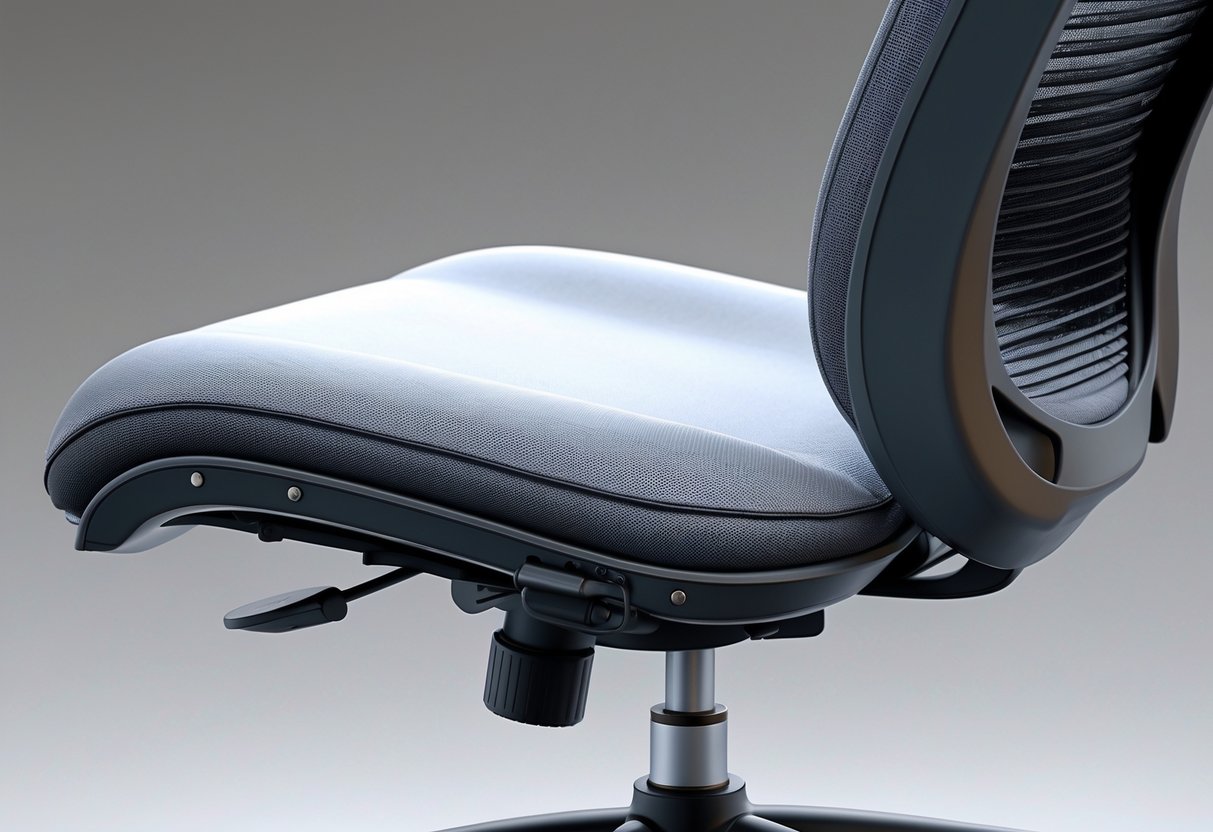
The seat pan is the base of any ergonomic gaming chair setup. If you get the depth right, you won’t feel pressure on your legs, and enough width spreads your weight out for those long gaming sessions.
Understanding Seat Pan Design
The seat pan is just the flat part you sit on. It really matters for posture and avoiding discomfort in marathon gaming stretches.
A good seat pan spreads your body weight evenly. That way, you don’t get numb or sore spots on your legs and hips.
A few comfort measurements:
- Width should be at least 2.5cm wider than your hips on each side
- Depth needs to fit your thigh length but not press behind your knees
- Padding should be firm enough to hold you up but not so hard it hurts
Most gaming chairs land between 43-53cm wide and 38-53cm deep. Still, not everyone fits those numbers.
Some chairs let you adjust the seat pan with sliders. You can change the depth by 5-8cm to fit your body better.
Optimising Seat Depth
Getting seat depth right helps with circulation and keeps your back supported. Leave 5-8cm of space between the back of your knees and the seat edge.
First, measure your thigh. Sit on something flat and measure from your hip to the back of your knee. That’s your max comfortable seat depth.
How to spot a bad fit:
- Pressure behind your knees? Too deep.
- Not enough back support when you sit back? Too shallow.
- Dangling feet or compressed legs? Something’s off.
If your chair has a seat slider, move it until you can fit 2-3 fingers between your knees and the seat edge. That keeps blood flowing and your lower back happy.
A lot of gaming chairs now offer 5-8cm of depth adjustment. Shorter gamers especially appreciate this, since standard chairs often feel too deep.
Selecting Appropriate Seat Width
Seat width makes a big difference for stability and comfort. The pan should be wide enough so you don’t feel squeezed, but not so wide you lose side support.
Sit down and measure your hip width. Add 5cm, and that’s your minimum seat width. That extra bit lets you shift around and try different positions.
Width guidelines:
| User Type | Recommended Width | Notes |
|---|---|---|
| Petite gamers | 43-46cm | Stops you from sliding around |
| Average build | 46-51cm | Fits most gaming chairs |
| Larger users | 51-56cm+ | Gives you room to move |
Chairs with waterfall edges help by easing pressure on your thighs. This curved front stops the seat edge from digging into your legs.
Some models come with adjustable side bolsters. You can tweak the seat width to match your body and how you like to game.
Armrests and Upper Body Support
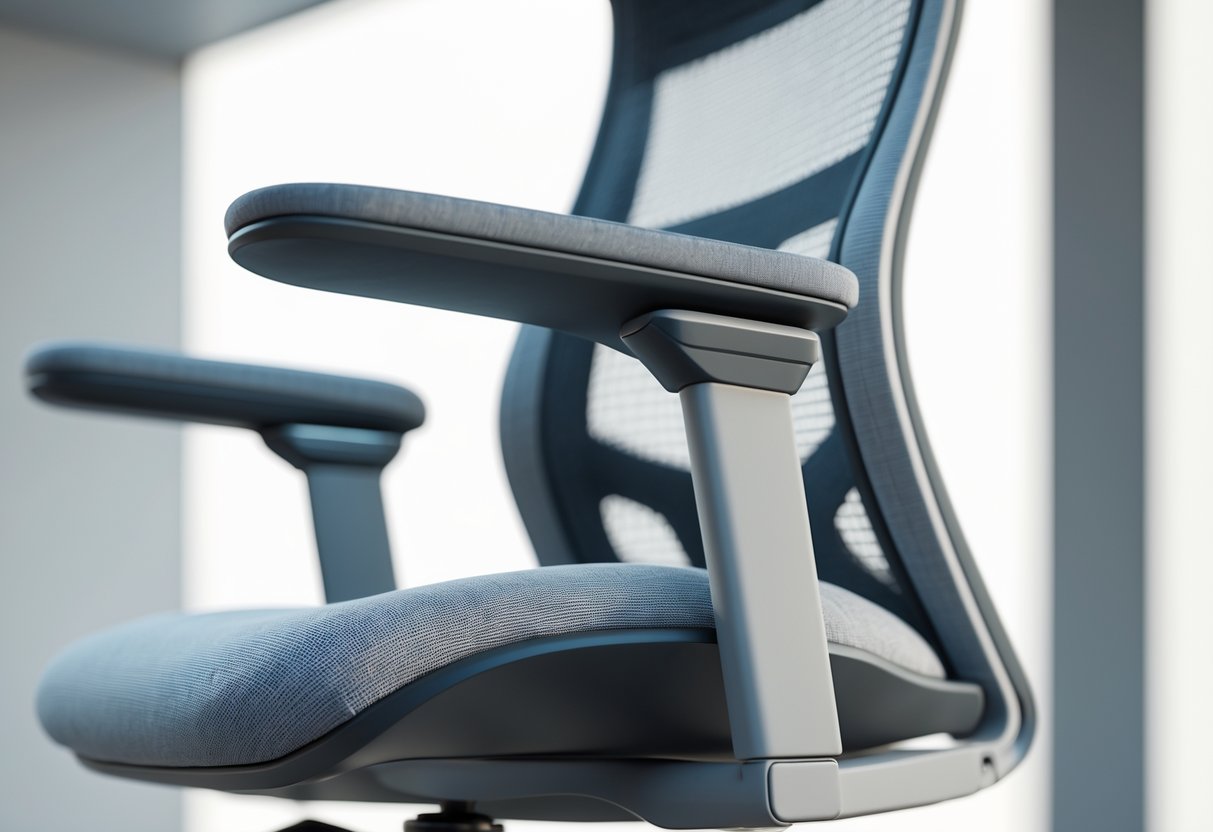
Armrests support your shoulders, neck, and arms during long gaming sessions. If you set them up right, they help prevent muscle strain and keep your posture in check.
Types of Armrests
Most gaming chairs offer a few armrest styles. Fixed armrests stay put and give basic support. They’re common on cheaper chairs but don’t let you adjust much.
Adjustable armrests let you change the height and sometimes the width. These work better for different body types and desk setups.
4D armrests move in four ways—height, width, depth, and angle. If you love tinkering to find the perfect spot, these are the ones.
Some chairs have flip-up armrests that get out of your way completely. Handy if you need extra room or want to tuck your chair in.
Gel-padded armrests feel softer for long stretches. They cut down on pressure points for your elbows and forearms.
Memory foam padding shapes itself to your arms over time. Some gamers say it’s comfier than the usual foam.
Armrest Adjustability
Set armrest height so your shoulders relax and your elbows bend at 90 degrees. Your arms should rest naturally—no shrugging and no drooping.
Width adjustment brings armrests in line with your arms. Too narrow? You’ll squeeze in. Too wide? You’ll reach out and strain.
Depth adjustment lets you move armrests closer or farther from your body. That’s useful for different arm lengths and desk depths.
Angle adjustment tilts armrests in or out. This helps if you switch between typing, using a mouse, or playing with a controller.
| Adjustment Type | Benefit | Common Issue |
|---|---|---|
| Height | Shoulder support | Too high makes you hunch |
| Width | Natural arm position | Fixed width doesn’t fit all |
| Depth | Elbow comfort | Can’t reach desk right |
| Angle | Task-specific support | Basic chairs often lack this |
Test the adjustments while you sit at your desk. Make small tweaks and see what feels best during real gaming or work.
Supporting Shoulder and Arm Health
Well-set armrests take a lot of the load off your upper body muscles. They support your arms so your shoulders don’t have to do all the work.
Without armrests, your shoulders work overtime to hold your arms up. That leads to fatigue and, honestly, neck pain after a while.
Using armrests right also encourages better sitting habits. When your arms feel comfortable, you’ll probably sit back in your chair more naturally.
Armrests can help you get in and out of your chair, too. You can push off them when you stand up after a long session.
But, if the armrests are too high, your shoulders will hunch. Too low, and you’ll slouch to reach them.
Some gamers skip armrests for games that need fast arm movement. Fighting games or shooters sometimes work better without anything in the way.
Think about your gaming style when you pick armrest features. Strategy gamers usually want full support, but FPS players might need more freedom.
Neck and Head Support
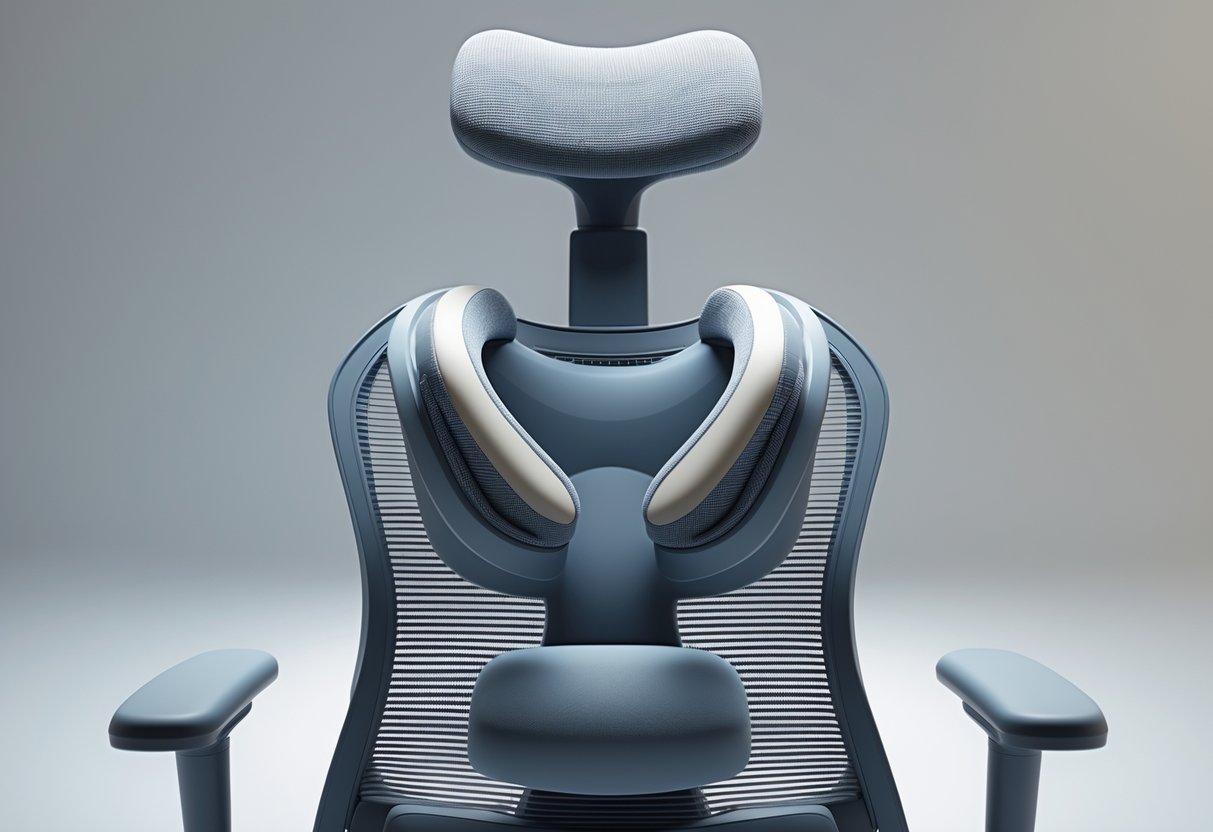
Good neck support stops that forward head posture—what people call “tech neck”—and keeps you from getting chronic pain during long sessions. A solid headrest keeps your spine in line and eases neck strain.
Incorporating Headrests
A headrest should cradle the base of your skull, not just your neck. Look for headrests you can adjust for height and angle.
The headrest needs to sit at the right spot for your body. When you lean back a bit, it should support the curve where your head meets your neck. That way, your head doesn’t jut forward when you’re focused on the screen.
Look for these features:
- Height adjustment (at least 5cm)
- Angle tilt (forward and back)
- Curve that matches your neck’s shape
- Firm but comfy padding
Fixed headrests on budget chairs often don’t work for everyone. If you’re taller or shorter than average, they can miss the mark. Adjustable headrests cost more but really help prevent neck pain.
Neck Support for Prolonged Sitting
Long gaming sessions put a lot of strain on your neck. Without support, you’ll probably end up with tension headaches and sore shoulders after a few hours.
Keep your neck neutral. Your ears should line up with your shoulders—not poke forward toward the screen. This takes the extra load off your neck bones and muscles.
What helps:
- Dynamic lumbar support to keep you upright
- Recline function for quick breaks (110-120 degrees is good)
- Armrests that lower shoulder tension
- Breathable materials to keep you cool
Take a short break every 30-60 minutes and reset your posture. Even with the best neck support, sitting still too long wears out your muscles. A quick stretch or change of position keeps you feeling better.
Heads up: Cheap chairs with bad neck support can make things worse. It’s worth investing in good ergonomics now instead of fixing pain later.
Tilt and Recline Mechanisms
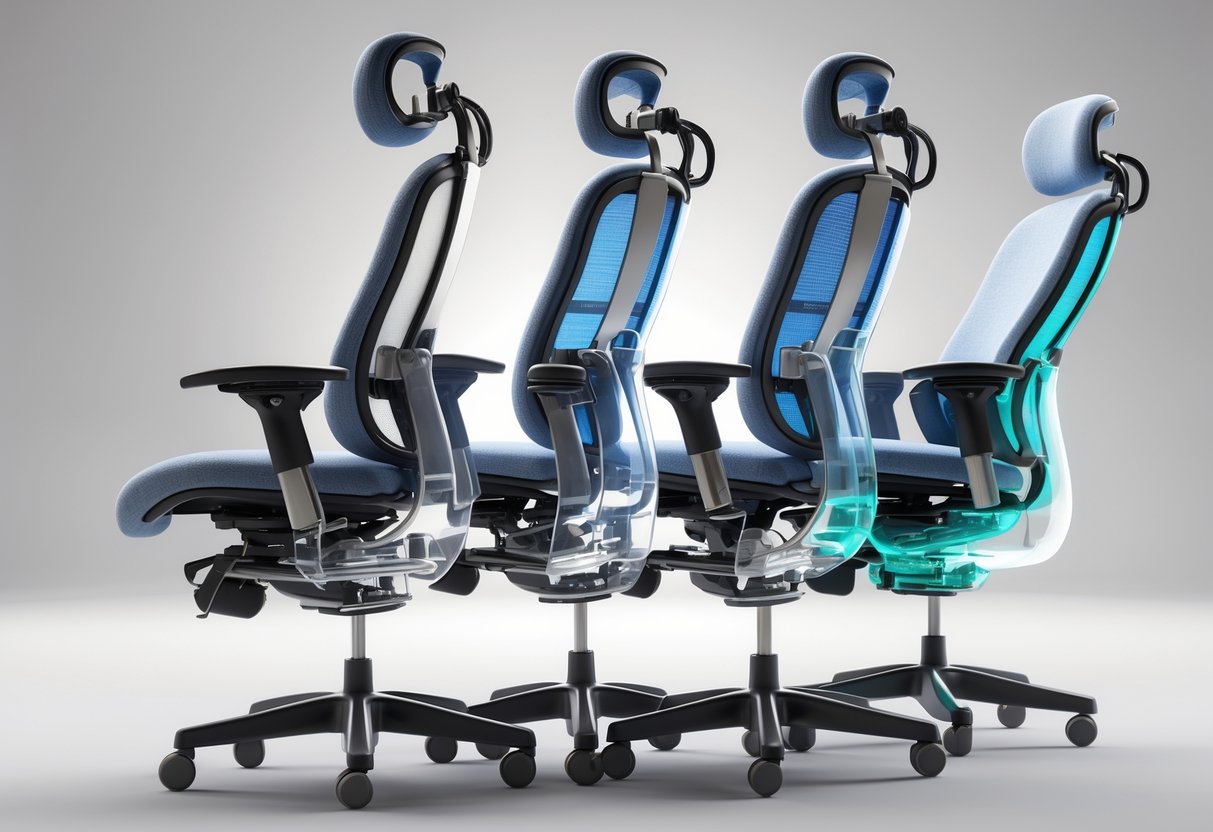
Chair tilt mechanisms let you move and shift around during the day, which takes pressure off your spine. These systems help you keep better posture and give your body some much-needed movement during long work or gaming sessions.
Benefits of Chair Tilt Functions
The tilt mechanism in your chair does a lot for your comfort and health. When you lean back, you can reduce lower back disc pressure by up to 40%.
Tilting back also helps blood flow through your legs and back. If you sit in one spot all day, blood flow gets restricted.
Benefits you’ll notice:
- Less pressure on your lower back
- Better circulation in your legs and spine
- Less muscle tension in your neck and shoulders
- Easier breathing as your chest opens up
Different tilt types feel different. Synchro-tilt moves the backrest and seat at a 2:1 ratio. So, if your backrest tilts 8 degrees, your seat moves 4 degrees.
Centre-tilt moves both seat and back at the same angle. It’s cheaper but can lift your knees when you lean back.
Knee-tilt puts the pivot point near your knees. This keeps your feet on the floor as you tilt back.
Maintaining Movement and Adjusting Posture
Moving regularly with tilt functions stops your muscles from getting stiff. Try to change your position every 30-60 minutes to keep blood moving.
Tilt tension controls let you set how much force it takes to recline. Heavier folks need more tension; lighter ones need less for easy movement.
Most good chairs have tilt lock positions at various angles. Lock it at 5-10 degrees for work or 15-20 degrees if you’re reading.
Weight-sensitive tilt reacts to how you shift your weight. These chairs adjust automatically as you move, so no manual controls needed.
Recline is a bit different from tilt—it just changes the backrest angle. You can lean back for a break without moving the seat. Most chairs max out at about 155 degrees for real rest.
Materials, Breathability, and Durability
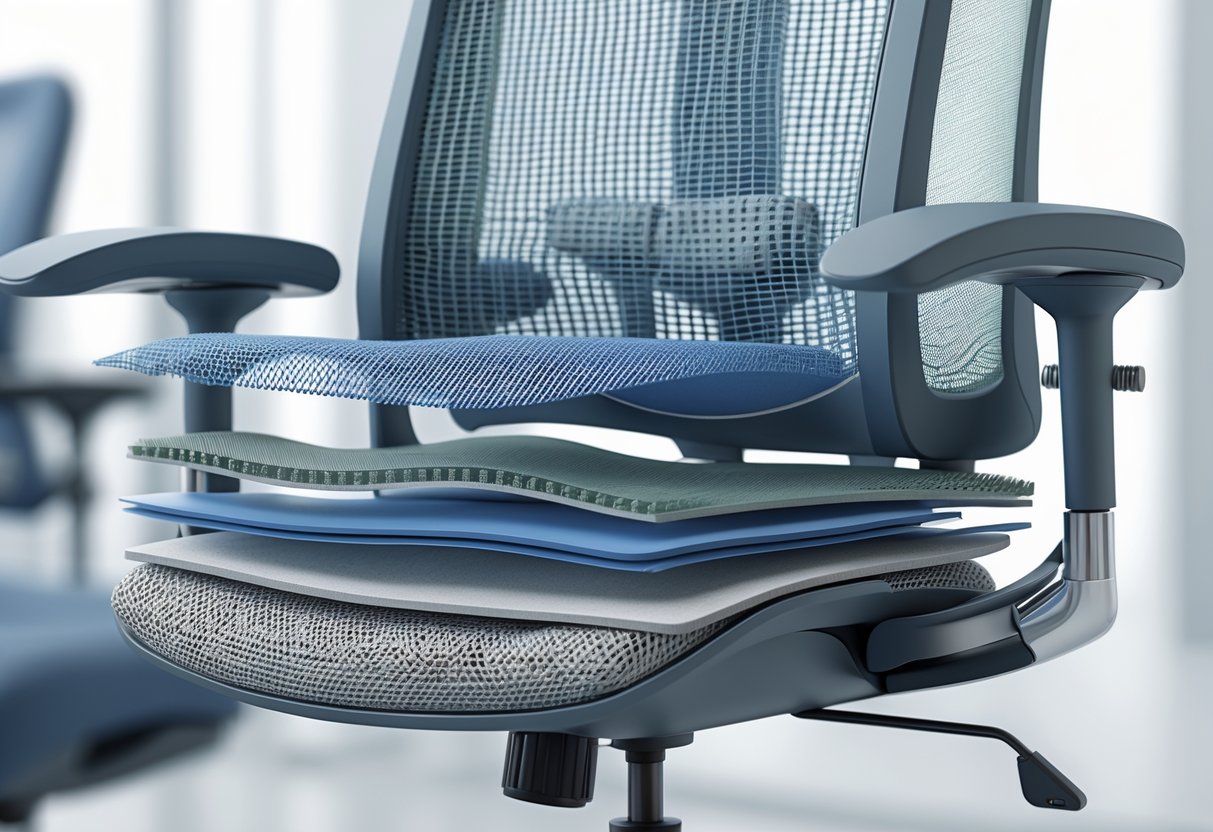
The materials you pick for your chair make a real difference in comfort and performance over long gaming sessions. Breathable fabrics keep you cool when things heat up, and good padding stops fatigue from sneaking in and ruining your focus.
Choosing Breathable Chair Materials
Mesh materials really shine when you want to stay cool during those long gaming marathons. Air moves easily through the backrest and seat, which makes a surprising difference.
Most mesh chairs use synthetic fibres that flex as you shift around. That stretchiness helps when you need to react fast in competitive games.
Breathable materials work best if your gaming room stays reasonably cool. If your setup heats up from all the monitors and gear, mesh almost becomes a must-have.
Fabric chairs allow some airflow, but the quality varies a lot. Aim for chairs with moisture-wicking properties so sweat doesn’t stick around.
| Material Type | Breathability | Best For |
|---|---|---|
| Mesh | Excellent | Hot gaming rooms |
| Fabric | Good | Cool environments |
| Leather | Poor | Short sessions |
| Faux leather | Fair | Budget builds |
Leather looks sharp but traps heat fast. Many streamers skip leather chairs since they get sticky during those long sessions.
A lot of newer chairs mix materials—mesh backs with padded seats. That combo gives you cooling where you need it and keeps things comfy.
Padding and Comfort Factors
Memory foam padding molds to your body as you use the chair. After a few weeks, it feels like it was made for you.
High-density foam sticks around longer than the cheap stuff. Budget chairs usually use low-grade foam that goes flat in no time.
Cold cure foam holds its shape better than regular foam. Many gaming chairs put this premium material right where you need the most support.
Padding thickness doesn’t matter as much as quality. Thick, cheap foam feels nice at first but breaks down fast.
Look for chairs with different density zones. Firmer foam under your lower back and softer foam under your thighs makes a noticeable difference.
Some chairs use gel-infused padding to keep things cooler. If you tend to overheat during intense games, this can help.
Warning: Chairs with thin padding over hard plastic get uncomfortable quickly. They can mess up your posture if you sit for hours.
Mobility: Swivel Base and Casters
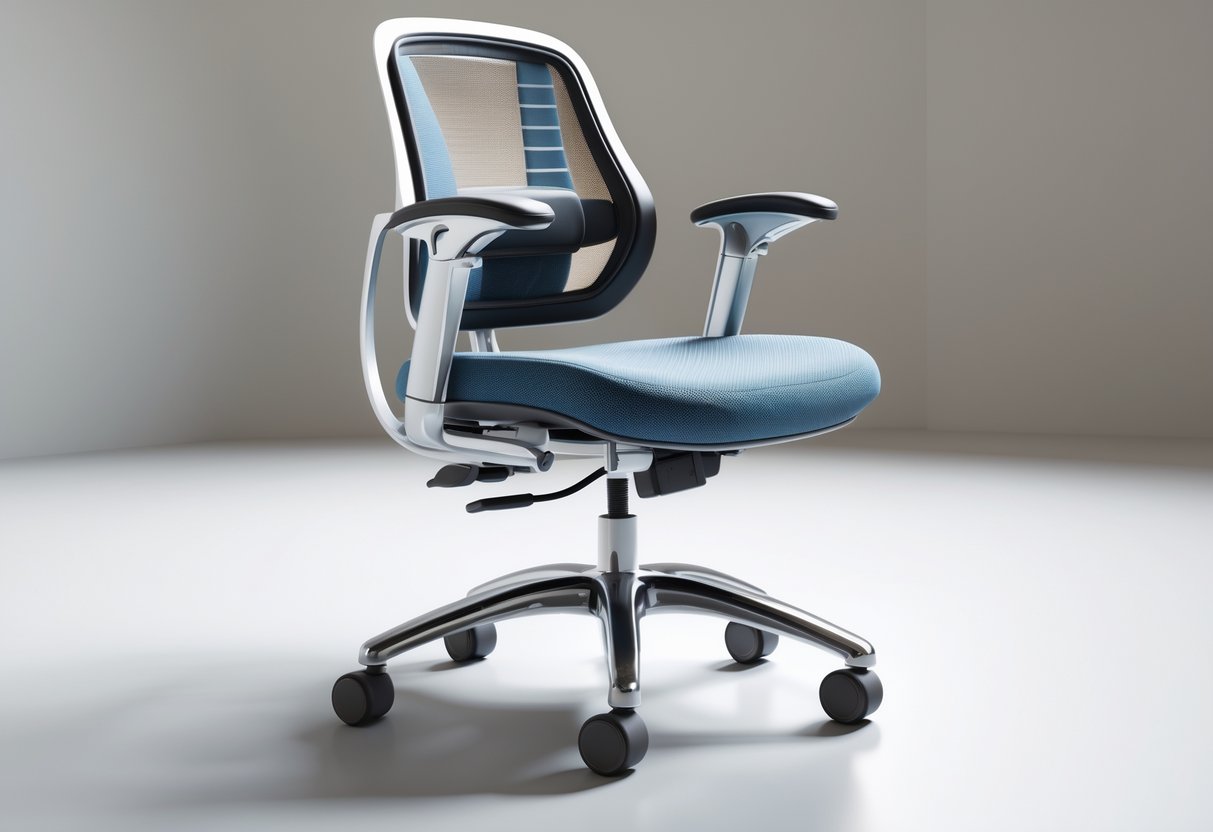
A chair’s swivel base lets you spin 360 degrees, and casters make it easy to roll around your workspace. These two features take the strain out of reaching and twisting.
Swivel Base Functionality
The swivel base anchors your chair. It connects the seat to the wheels underneath.
A good swivel mechanism spins smoothly without sticking or wobbling. You can turn to face different parts of your desk without dragging the whole chair.
Key benefits of proper swivel functionality:
- Reduces spine twisting when you reach for things
- Makes it easier to chat with colleagues
- Helps you avoid awkward postures
- Keeps your seat steady as you turn
Pick swivel bases made from sturdy stuff like steel or reinforced plastic. Cheaper ones loosen up and get wobbly pretty fast.
The swivel should feel smooth but not spin wildly. Too much spinning can actually make you dizzy if you’re sitting for hours.
Selecting the Appropriate Casters
You need to match your casters to your floor and how much you move. The wrong wheels can scratch floors or make the chair hard to move.
For hard floors (wood, tile, laminate):
- Go with soft rubber or polyurethane casters
- Avoid scratches and scuffs
- Roll quietly
For carpeted floors:
- Use hard plastic casters
- They glide through the carpet better
- Less effort to move
Check the weight rating on your casters. Most standard office wheels hold up to 110kg (about 17 stone). If you’re heavier, look for reinforced casters.
Caster size matters:
- 50mm wheels are standard
- 65mm wheels roll better on thick carpet
- Locking casters stop your chair from sliding when you don’t want it to move
Swap out worn casters right away. Bad wheels make the chair jerk and can wreck your floor.
Fitting the Chair to the Individual
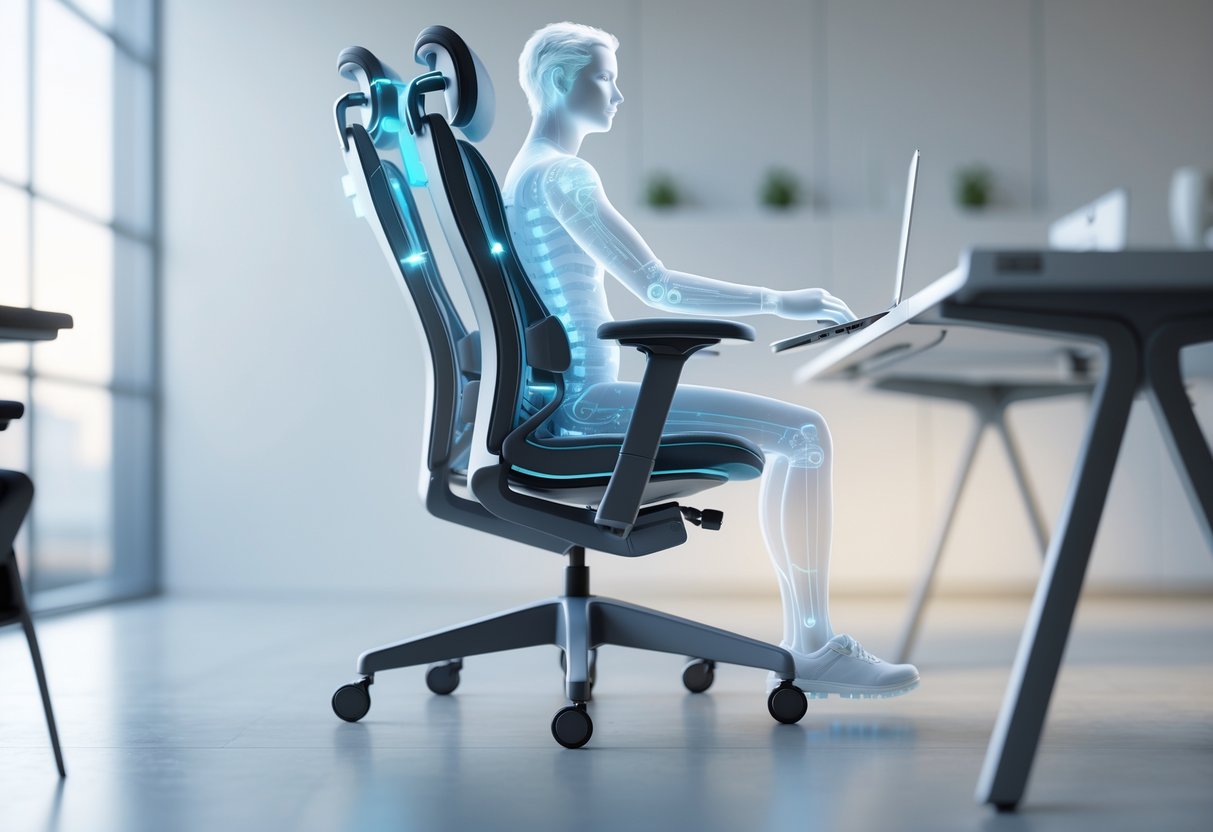
Everyone needs a slightly different chair setup. Your body type, height, and habits all play a role. The two big things? Get your spine aligned and adjust support for your own build.
Ensuring Proper Spinal Alignment
Your spine has three natural curves. The lower back curves in, the middle back curves out, and your neck curves in again.
Seat height changes everything. If you sit too low, your back rounds and flattens. Even good lumbar support can’t fix that.
Too high and you get pressure behind your knees. You want your feet flat and thighs level.
The seat-to-backrest angle is crucial. A tight angle (about 115°) flattens your lower back. A more open angle (around 135°) helps keep that natural curve.
If you keep sliding away from the backrest, try opening the angle more. If you never use the backrest, maybe it’s too open.
Lumbar support should feel firm but not pokey. It needs to line up with your lower back curve. Women sometimes need the lumbar support set a bit higher.
Customising Support for Body Type
Weight capacity matters. Most office chairs handle up to 250 pounds. If you weigh more, go for a chair built for higher loads.
Seat depth depends on your legs. Leave 1-3 inches between your knees and the seat edge. Taller folks need more depth, shorter folks need less to keep their back supported.
Backrest height depends on what you do. Low, narrow backs work for active tasks. Taller backs that reach your shoulders are better if you like to recline.
Armrest placement changes with your build. Some people need armrests just 4 inches up, others need 14. Match them to your bent elbow height so you’re not shrugging your shoulders.
Seat width should be about 2 inches wider than your hips. That gives you room to move and keeps support in the right place.
Reducing Health Risks and Promoting Wellbeing
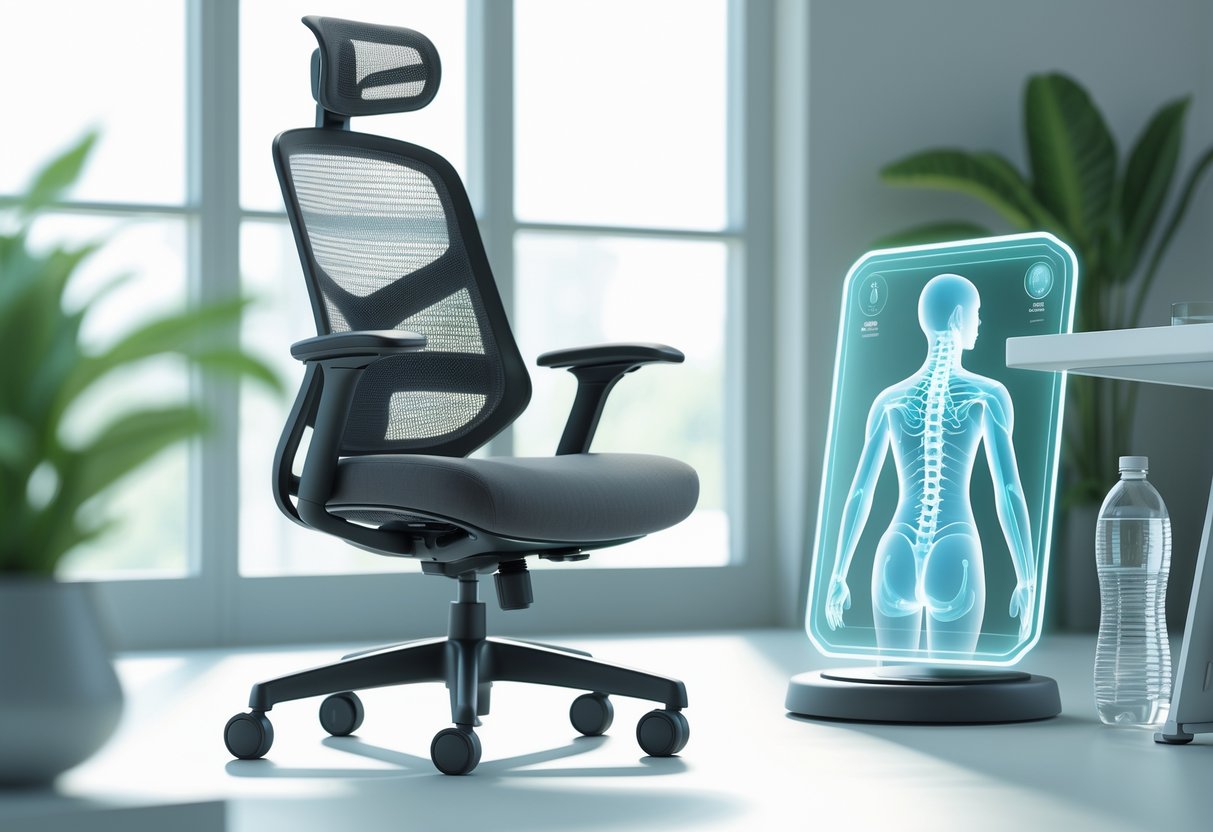
When you set up your chair right, you can actually prevent back pain and lower your chances of developing musculoskeletal problems. These benefits add up over time and can really boost your health and work.
Preventing Back Pain and Strain
If you sit poorly, your spine curves the wrong way. That puts extra pressure on your discs and muscles.
Ergonomic chairs fix this by giving your lower back the right lumbar support. That keeps your spine lined up while you work.
Research shows people using ergonomic chairs report less back pain. One study found pain dropped across different workplaces in just four months.
Key features that prevent strain:
- Adjustable seat height so feet stay flat
- Seat depth that supports thighs but doesn’t press behind your knees
- Backrest that follows your spine’s S-curve
- Armrests at a height that keeps elbows at 90 degrees
Without support, you shift around to get comfortable. That creates muscle tension in your neck and shoulders.
Ergonomic seating stops those little compensations. Your muscles can finally relax instead of working overtime.
Long-Term Health Benefits
Using ergonomic seating regularly stops musculoskeletal disorders from creeping up on you after years at a desk. Treating those problems later costs a fortune.
A supportive chair also helps your circulation. When you don’t slouch or perch, blood moves better through your legs and back.
Better posture opens up your lungs, too. You breathe easier and get more oxygen to your brain, which helps you focus.
Long-term benefits include:
- Less risk of chronic back and neck pain
- Lower odds of disc problems
- Improved muscle strength and flexibility
- More energy during the day
- Fewer headaches from neck tension
Studies show people with ergonomic furniture miss less work. They’re also happier and more productive.
Investing in a good chair saves money on healthcare in the long run. It’s way cheaper to prevent problems than to fix them later.
Your body gets used to whatever position you use most. A good chair trains your muscles to hold better posture, even when you’re away from your desk.
Frequently Asked Questions
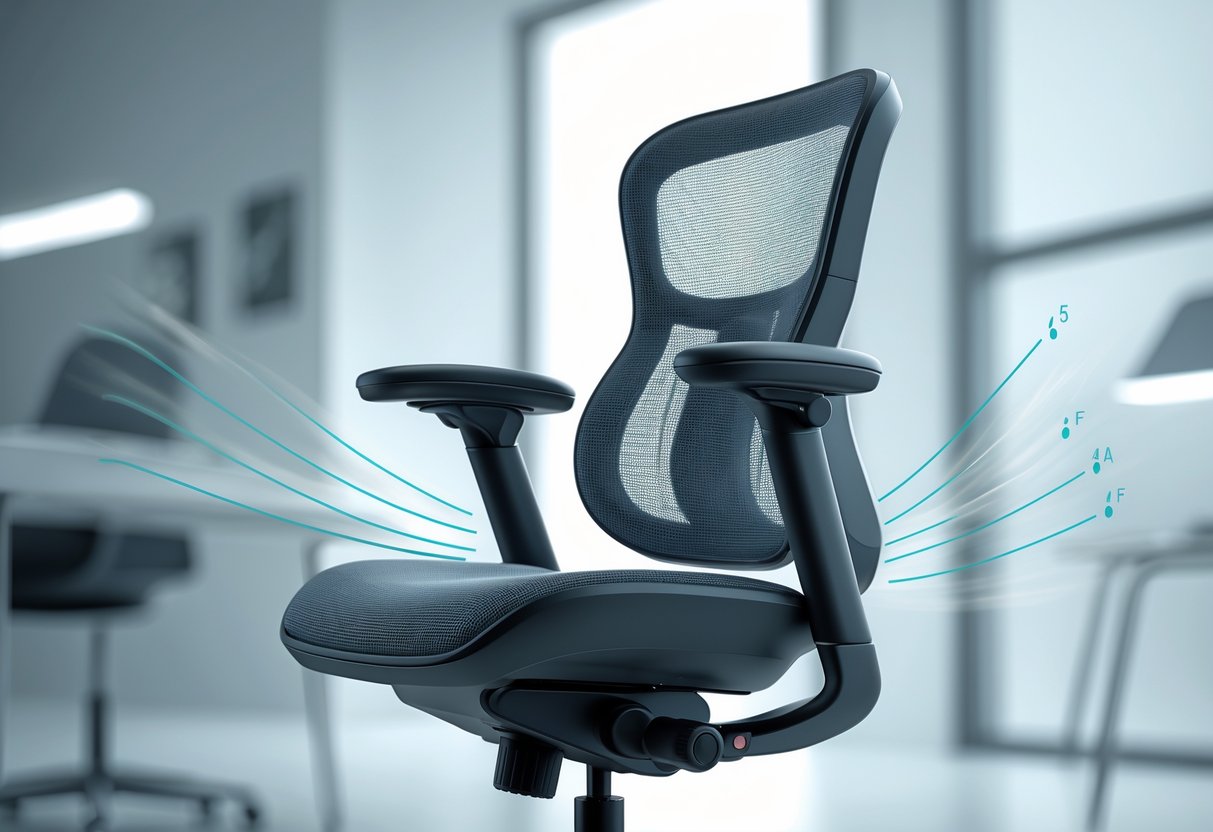
How you set up your chair affects everything from daily comfort to your long-term health. Here are some common questions and straightforward answers for anyone spending hours at a desk.
What are the key features to look for in an ergonomic office seat?
Adjustable seat height tops the list. You want your feet flat and thighs parallel to the floor.
Lumbar support that fits your lower back curve keeps you from slouching. Look for chairs where you can move this support up and down, and in or out.
Armrests should move up and down, and maybe side to side. They need to support your arms without making your shoulders tense.
Seat depth matters too. Aim for two or three inches between the seat edge and the back of your knees.
A tilting backrest lets you lean back sometimes, which takes pressure off your spine.
How can adjusting your chair enhance your comfort and productivity at work?
Start by setting seat height so your elbows bend at about 90 degrees when typing. That helps your shoulders and wrists stay relaxed.
Adjust lumbar support to fill the space in your lower back. You want support, not a shove forward.
Move armrests so your shoulders can drop. If they’re too high, you’ll feel it in your neck.
Tilt your backrest a bit—somewhere between 100 and 110 degrees. That’s more comfortable than sitting bolt upright.
When you’re not fidgeting or shifting, it’s easier to focus and get work done.
What is the ideal way to sit to avoid back pain during long periods of desk work?
Keep your back against the lumbar support. Don’t perch on the edge or lean forward for too long.
Your head should line up over your shoulders, not jut forward to see the screen.
Balance your weight on both hips. Crossing your legs or sitting on one foot throws things off and adds tension.
Keep your feet flat on the floor or use a footrest. Dangling legs put pressure on your thighs.
Let your shoulders relax. Don’t let them creep up toward your ears.
Could you suggest a daily routine to maintain good posture while seated?
Set a reminder every hour to check your posture. Quick self-corrections stop bad habits before they settle in.
Do a few shoulder rolls every 30 minutes. Rolling them back helps undo that hunched-forward desk posture.
Stand up and walk around for a couple of minutes every hour. It gets your blood moving and gives your spine a break.
Try gentle neck stretches during breaks. Look left, right, up, and down to keep your neck loose.
At the end of the day, do some back extensions. Stand, put your hands on your lower back, and gently arch backward.
What’s the recommended amount of time to sit before taking a break or changing positions?
Take a break to move every 30 to 60 minutes. You don’t need to stop working—just change your position.
Stand up for at least two minutes every hour. Studies say this cuts the risks of sitting too long.
Even 30-second micro-breaks every 20 minutes help. Stand, stretch, or walk to the water cooler.
Try the 20-20-20 rule: every 20 minutes, look at something 20 feet away for 20 seconds and shift your posture.
Pay attention to your body. If you feel stiff or sore, that’s your sign to move—no matter what the clock says.
How does seat depth impact your sitting posture and overall wellbeing?
Getting the seat depth right keeps your legs’ circulation flowing. If the seat’s too deep, you’ll either lose that lower back support or end up squishing the backs of your knees.
Aim for about two to three inches of space between your knees and the seat edge. That little gap keeps pressure off the blood vessels behind your knees.
Plenty of chairs let you adjust the seat depth or use a sliding seat pan. If your chair doesn’t, you can just toss on a lumbar cushion to make it work.
The wrong seat depth pushes you into awkward positions. You might find yourself perching forward and missing out on back support, or scooting back and cutting off leg circulation.
When you get the depth just right, you can actually use the whole backrest and still keep your legs comfortable. It’s a small detail, but it really helps your spine stay happy during those long workdays.

